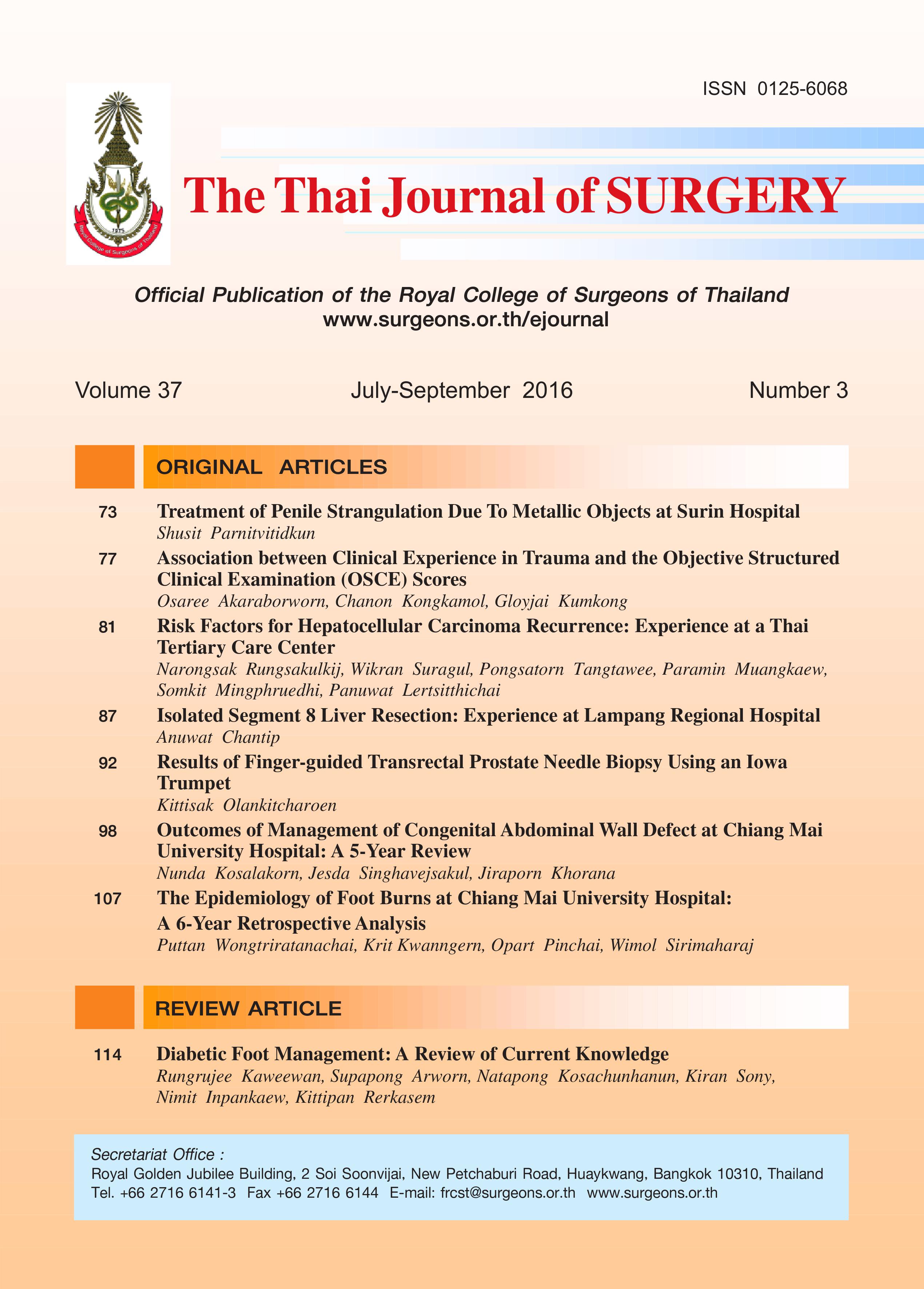Isolated Segment 8 Liver Resection: Experience at Lampang Regional Hospital
Keywords:
Segment 8 Liver resection, Glissonian pedicle approachAbstract
Objective: Segment 8 liver lesion is rare, and limited resection of this lesion is difficult to perform because ofits location, and parenchyma transection is often needed to obtain the line of ischemic demarcation on liver surface.
The aim of this study was to present our experience of segment 8 of liver resection with intraoperative duplex
ultrasound guide.
Method: Isolated segment 8 liver resection was performed on four patients with liver tumors between October
2013 and September 2014. The Glissonian pedicle approach at hilum of liver without parenchyma dissection was
done, after complete mobilization of right lobe of liver. Transparenchymal ligation of segment 8 portal venous
branches, using intraoperative ultrasound guide, was used to accomplish the resection with the kellyclasia technique
Results: There was no perioperative complication and no mortality. The mean transection time was 206
minutes. The average amount of blood loss was 400 mL. Pathological examination showed adequate margin of tumor
resection.
Conclusion: Isolated segment 8 liver resection performed with “Glissonian pedicle” approach is safe, and
achieved adequate anatomical resection margin. This parenchyma sparing resection is an effective alternative to
major hepatectomy.
References
liver. World J Surg 1982;6:3-9.
2. Billingsley KG, Jarnagin WR, Fong Y, Blumgart L,H. Segment
oriented hepatic resection in the management of malignant
neoplasms of the liver. J Am Coll Surg 1998;187:471-81.
3. Makuuchi M, Hasegawa H, Yamazaki S. Intraoperative
ultrasonic examination for hepatectomy. Ultrasound Med
Biol 1983;Suppl 2:493-7.
4. Bismuth H, Houssin D, Castaing D. Major and minor segmentectomies
“reglees” in liver surgery. World J Surg 1982;6:10-
24.
5. Couinaud C. Le Foie, Etudes Anatomiques et Chirurgicales.
Paris, France: Masson & Cie;1957.
6. Healey JE, Schroy PC. Anatomy of the biliary ducts within the
human liver. Arch Surg 1953;66:599-616.
7. Andrus CH, Kaminski DL. Segmental hepatic resection utilizing
the ultrasonic dissector. Arch Surg 1986;121:515.
8. Mazziotti A, Maeda A, Ergolani G, Cescon M, Grazi GL,
Pierangeli F. solated liver resection of segment 8 for liver
tumors: a new approach for anatomical segmentec-tomy.
Arch Surg 2000;135:1224-9.
9. Strasberg SM, Belghiti J, Clavien PA, Gadzijev EM, Garden
JO, Lau WY, et al. Terminology of liver anatomy and resections.
HBP Surg 2000;2:333-9.
10. De Graaf W, Van Lienden KP, Dinant S, Roelofs JJ, Busch OR,
Gouma DJ, et al. Assessment of future remnant liver function
using hepatobiliary scintigraphy in patients undergoing major
liver resection. J Gastrointest Surg 2010;14:369-78.
11. DeMatteo RP, Palese C, Jarnagin WR, Sun RL, Blumgart LH,
Fong Y. Anatomic segmental hepatic resection is superior
to wedge resection as an oncologic operation for colorectal
liver metastases. J Gastrointest Surg 2000;4:178-84.
12. Makuuchi M, Hishikura Y, Kawasaki S, Tan D, Kosuge T,
Takayama T. Personal experience of right anterior segmentectomy
(segment V and VIII) for hepatic malignancies.
Surgery 1993;114:52-8.
Downloads
Published
How to Cite
Issue
Section
License
Articles must be contributed solely to The Thai Journal of Surgery and when published become the property of the Royal College of Surgeons of Thailand. The Royal College of Surgeons of Thailand reserves copyright on all published materials and such materials may not be reproduced in any form without the written permission.



